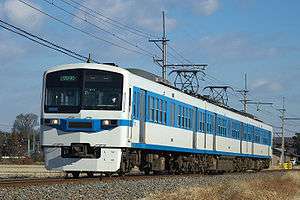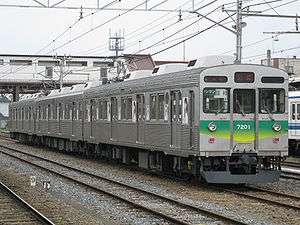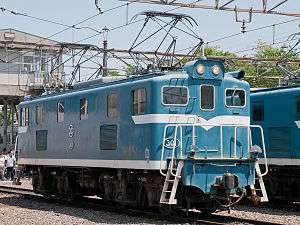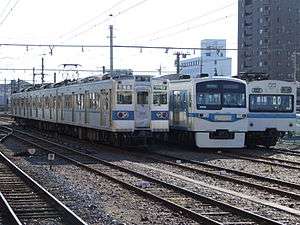Chichibu Main Line
| Chichibu Main Line | |
|---|---|
|
Chichibu Railway 5000, 6000, and 1000 series EMUs stabled next to Kumagaya Station, December 2007 | |
| Overview | |
| Native name | 秩父本線 |
| Locale | Saitama Prefecture |
| Termini |
Hanyū Mitsumineguchi |
| Stations | 35 |
| Operation | |
| Opened | 1901 |
| Owner | Chichibu Railway |
| Depot(s) | Hirosegawara |
| Technical | |
| Line length | 71.7 km (44.6 mi) |
| Number of tracks | 1 |
| Track gauge | 1,067 mm (3 ft 6 in) |
| Minimum radius | 149 m |
| Operating speed | 85 km/h (55 mph) |

The Chichibu Main Line (秩父本線 Chichibu-honsen) is a railway line in Japan, owned by Chichibu Railway, which links Hanyū and Mitsumineguchi, both in Saitama Prefecture.
Locals living around the line call it the Chichibu Line (秩父線 Chichibu-sen). This is not to be confused with Seibu Railway's nearby Seibu Chichibu Line, which is almost always referred to in full to avoid ambiguities.
Stations
| Station | Japanese | Distance (km) | Local service to/from Seibu Chichibu Line | Chichibuji Express |
SL Paleo Express | Transfer | Location | ||
|---|---|---|---|---|---|---|---|---|---|
| Between Stations |
Total | ||||||||
| Hanyū | 羽生 | - | 0.0 | ○ | Tōbu Isesaki Line | Hanyū | |||
| Nishi-Hanyū | 西羽生 | 1.2 | 1.2 | | | |||||
| Shingō | 新郷 | 1.4 | 2.6 | | | |||||
| Bushū-Araki | 武州荒木 | 2.2 | 4.8 | | | Gyōda | ||||
| Higashi-Gyōda | 東行田 | 2.5 | 7.3 | | | |||||
| Gyōdashi | 行田市 | 1.0 | 8.3 | ○ | |||||
| Mochida | 持田 | 1.8 | 10.1 | | | |||||
| Kumagaya | 熊谷 | 4.8 | 14.9 | ● | ● | Jōetsu Shinkansen, Hokuriku Shinkansen, Takasaki Line (Shōnan-Shinjuku Line, Ueno-Tokyo Line) | Kumagaya | ||
| Kami-Kumagaya | 上熊谷 | 0.9 | 15.8 | | | | | ||||
| Ishiwara | 石原 | 1.2 | 17.0 | | | | | ||||
| Hirose-Yachō-no-Mori | ひろせ野鳥の森 | 1.5 | 18.5 | | | | | ||||
| Ōasō | 大麻生 | 1.3 | 20.3 | | | | | ||||
| Aketo | 明戸 | 2.6 | 22.9 | | | | | Fukaya | |||
| Takekawa | 武川 | 1.9 | 24.8 | ● | ● | Chichibu Railway: Mikajiri Freight Line | |||
| Nagata | 永田 | 2.3 | 27.1 | | | | | ||||
| Omaeda | 小前田 | 3.4 | 30.5 | | | | | ||||
| Sakurazawa | 桜沢 | 1.4 | 31.9 | | | | | Yorii, Ōsato District | |||
| Yorii | 寄居 | 1.9 | 33.8 | ● | ● | Hachikō Line Tōbu Tōjō Line | |||
| Hagure | 波久礼 | 3.9 | 37.7 | | | ▼ | ||||
| Higuchi | 樋口 | 4.4 | 42.1 | | | | | Nagatoro, Chichibu District | |||
| Nogami | 野上 | 2.6 | 44.7 | ● | | | ||||
| Nagatoro | 長瀞 | 1.8 | 46.5 | ● | ● | ● | |||
| Kami-Nagatoro | 上長瀞 | 1.1 | 47.6 | ● | Through operation to Seibu-Chichibu (Seibu Chichibu Line) | | | | | ||
| Oyahana | 親鼻 | 1.6 | 49.2 | ● | | | | | Minano, Chichibu District | ||
| Minano | 皆野 | 1.6 | 50.8 | ● | ● | ● | |||
| Wadō-Kuroya | 和銅黒谷 | 2.6 | 53.4 | ● | | | | | Chichibu | ||
| Bushū-Haraya Freight Terminal | 武州原谷 | 2.1 | 55.5 | | | | | | | |||
| Ōnohara | 大野原 | 1.1 | 56.6 | ● | | | | | |||
| Chichibu | 秩父 | 2.4 | 59.0 | ● | ● | ● | |||
| Ohanabatake | 御花畑 | 0.7 | 59.7 | ● | ● | ● | Seibu Chichibu Line (Seibu-Chichibu) | ||
| Kagemori | 影森 | 2.7 | 62.4 | Through operation to Yokoze (Seibu Chichibu Line) | ● | ● | | | ||
| Urayamaguchi | 浦山口 | 1.4 | 63.8 | ● | | | | | |||
| Bushū-Nakagawa | 武州中川 | 2.4 | 66.2 | ● | | | | | |||
| Bushū-Hino | 武州日野 | 1.5 | 67.7 | ● | | | | | |||
| Shiroku | 白久 | 2.7 | 70.4 | ● | | | | | |||
| Mitsumineguchi | 三峰口 | 1.3 | 71.7 | ● | ○ | ● | |||
- Legend
- ● - All trains stop
- ○ - Some trains stop
- ▲ - Some trains pass
- ▼ - Trains make seasonal stops
- | - All trains pass
Rolling stock
- 5000 series 3-car EMUs (formerly Toei 6000 series) (from 1999)
- 6000 series 3-car EMUs x3 (formerly Seibu 101 series) (from March 2006)
- 7000 series 3-car EMUs x2 (formerly Tokyu 8500 series) (from March 2009)
- 7500 series 3-car EMUs (formerly Tokyu 8090 series) (from March 2010)
- 7800 series 2-car EMUs (formerly Tokyu 8090 series) (from 16 March 2013)
- 12 series passenger coaches (for Paleo Express)
- Class C58 steam locomotive (No. C58 363 for Paleo Express)
- DeKi 100 electric locomotives (x6)
- DeKi 200 electric locomotive (x1)
- DeKi 300 electric locomotives (x3)
- DeKi 500 electric locomotives (x7)
Source: [1]
-

Chichibu 6000 series(for Chichibuji Express)
-

Chichibu 7000 series
-

DeKi 102
-

DeKi 201
-

DeKi 301
-

DeKi 507
Rolling stock previously used
- 300 series 2-car EMUs (from 1959 until October 1992)
- 500 series 2-car EMUs (from 1957 until March 1992)
- 800 series 2-car EMUs (formerly Odakyu 1800 series) (from 1979 until 1990)
- 1000 series 3-car EMUs (formerly JNR 101 series) (from 1986 until March 2014)[2]
- 2000 series 4-car EMUs (formerly Tokyu 7000 series) (from 1991 until 2000)
- 3000 series 3-car EMUs x3 (formerly JR East 165 series) (from 1992 until December 2006)
- 43 series passenger coaches (for Paleo Express)
History
The Jōbu Railway (上武鉄道) opened the section between Kumagaya and Yorii on 7 October 1901 operated by the use of steam haulage.[3] The line was extended in stages, reaching Chichibu in 1914. The line was electrified at 1,200 V DC on 15 March 1918.[3] On 1 August 1922, the Chichibu Railway acquired the Hokubu Railway (北武鉄道) operating between Hanyū and Kumagaya.[3] The line reached Mitsumineguchi in 1930.
From 1 February 1952, The line voltage was raised to 1,500 V DC,[3] and in 1954 through services to/from the Tōbu Tōjō Line commenced.
The steam locomotive-hauled Paleo Express service commenced in 1988, and the following year through services to/from the Seibu Railway commenced.
Former connecting lines
- Kumagaya Station: The Tobu Kumagaya Line operated between 1943 and 1983.[4]
References
This article incorporates material from the corresponding article in the Japanese Wikipedia.
- ↑ 私鉄車両編成表 2010 [Private Railway Rolling Stock Formations - 2010]. Japan: JRR. August 2010. p. 15. ISBN 978-4-330-15310-0.
- ↑ 秩父鉄道「さよなら1003号貸切運転・撮影会ツアー」開催 [Chichibu Railway organizes "Farewell 1003 charter train and photographic tour"]. Tetsudō Daiya Jōhō Magazine (in Japanese). Vol. 43 no. 361. Japan: Kōtsū Shimbun. 2014. p. 74.
- 1 2 3 4 Terada, Hirokazu (19 January 2013). データブック日本の私鉄 [Databook: Japan's Private Railways]. Japan: Neko Publishing. p. 36. ISBN 978-4-7770-1336-4.
- ↑ Terada, Hirokazu (October 2003). 私鉄廃線25年 [25 Years of Abandoned Private Railways]. Japan: JTB Can Books. pp. 52–53. ISBN 4-533-04958-3.
External links
- Chichibu Railway website (Japanese)
